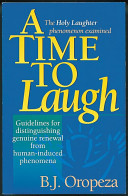B. J. Oropeza: A Time to Laugh
 B. J. Oropeza, A Time to Laugh: The Holy Laughter Phenomenon Examined (Peabody, Mass.: Hendrickson, 1995), 194 pages with ancient sources index.
B. J. Oropeza, A Time to Laugh: The Holy Laughter Phenomenon Examined (Peabody, Mass.: Hendrickson, 1995), 194 pages with ancient sources index.
In this 1995 book by B. J. Oropeza, a Pentecostal/charismatic examines the holy laughter phenomenon. This well-documented and well-researched book attempts to present the background and beginnings of the holy laughter movement and well as guidelines for discerning true renewal.
In the introduction, Oropeza says there are no easy answers to the many questions the holy laughter movement has raised. Chapter 2 is a brief history of the movement and profiles of the major players. “Uncovering the Teachings of Rodney Howard-Browne,” Chapter 3, appears to be relatively fair, but this author has no personal contact with Rodney Howard-Browne (and it appears that Oropeza has not either save his extensive research). Oropeza concludes that Browne is a “simple Pentecostal Preacher” who is not a part of the Word of Faith movement, but needs to clarify and/or practice more of what he preaches.
Chapter 4 attempts to cover the teachings of the Vineyard prior to 1995 and its association with the prophetic and eschatological aspects of the Kansas City Prophets, the Third Wave, the Kingdom Now and Latter Rain movements. Most Pentecostals will likely take exception to Oropeza’s eschatology in regards to what is the “Last Days Revival.” Many charismatics will also be uncomfortable with what appears to be a sweeping guilt by association Oropeza establishes between these separate movements and the holy laughter movement. If using similar phrases or Scriptures connects otherwise theologically divergent movements, all charismatics would be similarly indicted with all of charisma’s abuses.
Chapter 5 is a closer examination of the laughing, weeping, shaking, and animal noises which have been associated with the holy laughter renewal. Then Chapter 6 attempts to evaluate these phenomena in light of Scripture. Of special interest will be Oropeza’s evaluation of being “slain in the Spirit” and his refutation of being “drunk in the Spirit.” This excellent chapter is concluded by saying, “If we are to critique the Holy Laughter phenomena correctly, we must do so without assuming that it is wrong because it violates our own personal sense of propriety. Moreover, it is not enough to say there is no biblical evidence for it. We must show why it is contrary to Scripture, or why it undermines the Christian faith, or why it offends the biblical sense of propriety in worship” (p. 130).
In Chapter 7, Oropeza takes a look at the cultural backdrop of the church at Corinth to whom Paul wrote so much about the gifts and manifestations of the Spirit. In light of the pagan, hedonistic society of Corinth and Paul’s corrective against these elements moving into the church, Oropeza draws conclusions for today based on Paul’s intent. He writes, “Paul never doubts that the Holy Spirit is in fact touching the lives of the Corinthians, despite their disorder. Although other cults spoke in tongues and prophesied, Paul never questions that, despite the disorder, the Corinthians are still speaking in tongues and prophesying by the Spirit of God. . . . When God wants to touch lives, disorder is not going to stop him” (p. 143).
Chapters 8 and 9 are a brief chronicle of Eighteenth, Nineteenth, and Twentieth Century revivals and the spiritual phenomena attached to them. Oropeza examines some of the connections contemporary renewal leaders have claimed exist between these past movements and the holy laughter movement.


